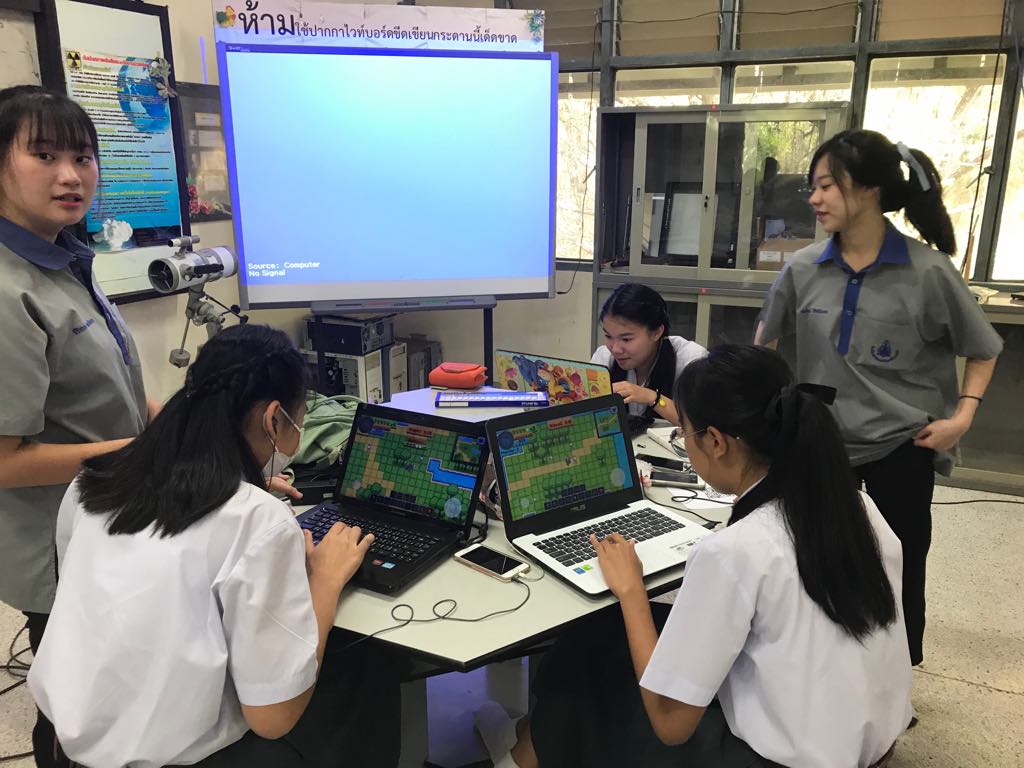Using Educational Digital Game to Promote Secondary School Students’ Physics Learning Performance in Static Electricity Lessons: A Failure to Learn
Main Article Content
บทคัดย่อ
An important role of educational computer games and pedagogies of game-based learning has been recognized widely in science education research and development. In the context of physics education, very few studies have developed physics learning games and transformed physics concepts into digital games. This research designed an educational digital game for promoting students’ learning of the physics concept of static electricity. Moreover, a game-based pedagogy, named student-associate game-based open inquiry (SAGOI), has been used to deliver the physics lesson to 34 eleventh-grade students who had never had a learning experience with the static electricity concept with educational digital games before. In the SAGOI learning process, the student must perform investigative planning and collaboration through an open-inquiry process with the support of a proposed digital game, called Electrilism War game, for 150 minutes. The results showed that the students’ post-class conceptual learning scores on static electricity concepts did not significantly increase compared to the pre-class scores. In terms of motivation toward physics, their self-efficacy (SE) in physics learning was significantly higher than before receiving the intervention. However, another four dimensions, i.e., intrinsic motivation (IM), career motivation (CM), self-determination (SD), grade motivation (GM), were not statistically different between pre-and post-test measurements. In addition, the students’ learning perceptions were higher than 60 percent, and there was no significant gender difference between female and male perceptions of the intervention. This finding could argue that using educational digital games in school physics education should be carefully considered and implemented for students learning. How to design an educational digital game and apply it with potential pedagogies should be centered for future study regarding the physics concept of static electricity.
Article Details

อนุญาตภายใต้เงื่อนไข Creative Commons Attribution-NonCommercial-NoDerivatives 4.0 International License.
เอกสารอ้างอิง
Bilal, E. & Erol, M. (2009). Investigating students’ conceptions of some electricity concepts. Latin-American Journal of Physics Education, 3, 193-201.
Boston, B. (2009). Player motivations: A psychological perspective. Computers in Entertainment, 7(2). https://doi.org/10.1145/1541895.1541902.
Brown, J., Collins, A. & Duguid, P. (1989). Situated cognition and the culture of learning. Educational Researcher, 18, 32–41.
Cheng, G. (2014). Exploring students’ learning styles in relation to their acceptance and attitudes towards using Second Life in education: A case study in Hong Kong. Computers & Education, 70,105-115.
De Castell, S., Jenson, J., and Taylor, N. (2007). Digital games for education: When meanings play. Intermediates, 9, 45-54.
Dontrisanor, T. (2016). The Influence of Inquiry Learning in Electricity Problem-based Digital Game on Eleventh Graders’ Conceptual Understanding, Problem-Solving Skill, and attitude toward Physics. (Unpublished master’s thesis). Khon Kaen University, Khon Kaen, Thailand.
Dontrisanor, T., Srisawasdi, N. & Kanjak, I. (2015). Using Problem-based Gaming Environment supported Conceptual Physics of Electric Current: A Result on Students' Perceptions. Proceedings of the 23rd International Conference on Computers in Education. (pp550-557). China: Asia-Pacific Society for Computers in Education.
Freitas, S. D. (2006). Learning in immersive worlds: a review of game-based learning. Bristol.
Gee, J. P. (2005). Why video games are good for your soul: Pleasure and learning. Champaign, IL: Common Ground Publishing.
Kiili, K. (2005). On educational game design: building blocks of flow experience. Doctoral thesis, Publications of Tampere University of Technology, Tampere University of Technology, Finland.
Lokayut, J. (2015). Implementation of Student-associated Game-based Open Inquiry (SAGOI) in Facilitating Eleventh Graders to Learn biology of Human Blood Circulation and Blood Donation. (Unpublished master’s thesis). Khon Kaen University, Khon Kaen, Thailand.
Maloney, D. P., O’Kuma, T. L., Hieggelke, C. J. & Heuvelen, A. V. (2001). Surveying students’ conceptual knowledge of electricity and magnetism. American Journal of Physics, 69(Suppl. 3), 69-71 https://doi.org/10.1119/1.1371296
Meesuk, K., & Srisawasdi, N. (2014). Implementation of Student-associated Game-based Open Inquiry in Chemistry Education : Results on Students’ Perception and Motivation. Liu, C.-C. et al. (Eds.). Proceedings of the 22nd International Conference on Computers in Education. (pp.219-226). Japan: Asia-Pacific Society for Computer in Education.
Nantakaew, N., & Srisawasdi, N. (2014). Investigating Correlation between Attitude toward Chemistry and Motivation within Educational Digital Game-based learning. Liu, C.-C. et al. (Eds.). Proceedings of the 22nd International Conference on Computers in Education. (pp.316-323). Japan: Asia-Pacific Society for Computer in Education
Salen, K., & Zimmerman, E. (2003). Rules of play Game Design Fundamentals. Cambridge: MITPress.
Savery, J. & Duffy, T. (1995). Problem-based learning: an instructional model and its constructivist framework. Educational Technology, 35, 31-38.
Sorense, B., & Meyer, B. (2007). Serious Games in language learning and teaching-a theoretical perspective. Proceedings of the 3rd International Conference of the Digital Games Research. (pp.559-566). Japan: Digital Games Research Association
Srisawasdi, N. (2015). Evaluation of motivational impact of a computer-based nanotechnology inquiry learning module on the gender gap. Journal of Nano Education, 7(1), 28–37.
Srisawasdi, N., Panjaburee, P. (2019). Implementation of game-transformed inquiry-based learning to promote the understanding of and motivation to learn chemistry. Journal of Science Education and Technology, 28, 152-164.
Stone, R. (2009). Serious games: virtual reality’s second coming?. Virtual Reality, 13(1), 1-2.
Suma, K., & W Sadia, I & M Pujani, N. (2018). Investigating 12th-Grade Students’ Prior Knowledge of Static Electricity Concepts. International journal of environmental & science education, 13(2), 163-172.
Sung, H., & Hwang, G. (2012). A collaborative game-based learning approach to improving students learning performance in science courses. Computers & Education, 63(2013), 43-51.
Toro-Troconis, M. & Partrigde, M. (2010). Designing Game-based learning activities in virtual worlds: experiences from undergraduate medicine. Gaming for Classroom-Based Learning: use of gaming in virtual worlds, 270–289.
Tychsen, A., Hitchens, M., & Brolund, T. (2008). Motivations for Play in Computer Role-Playing Games. Paper presented at the 2008 Conference on Future Play Research Play Share. 57-64.
Watson, W.R., Mong, C.J. & Harris, C. (2011). A case study of the in-class use of a video game for teaching high school history. Computers & Education, 56(2), 466-474.
Wu, W., Chiou, W., Kao, H., Hu,C. A., & Huang, S. (2012). Re-exploring game-assisted learning research: The perspective of learning theoretical base. Computers & Education, 59(2012), 1153– 1161.


